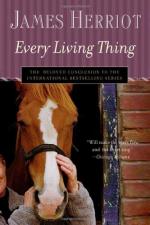|
This section contains 486 words (approx. 2 pages at 300 words per page) |

|
As in the earlier novels, Herriot utilizes an episodic structure. There are few continuous narrative lines, one of them being the narrator's search for a perfect house. Most chapters are more or less self contained, each with a climax of its own. A few seem to lack this climax, and are basically descriptive of an aspect of the country life. Once in a while, an episode has an overly strong moral, but fortunately those are few.
The story that seems to be the most overpoweringly moralistic concerns a hermit living in a simple canvas shelter with his little cat. In spite of his poverty, he is happy and content while his brother, a rich and powerful industrialist, is dissatisfied and loves no one.
Usually, however, Herriot does not get up on a pulpit but lets the reader see, appreciate, and experience the atmosphere and the people without being...
|
This section contains 486 words (approx. 2 pages at 300 words per page) |

|




